Kerala Plus One Botany Notes Chapter 11 Plant Growth and Development
Growth
Growth is defined as an irreversible permanent increase in the size of an organ or its parts of an individual cell.
It is accompanied by metabolic processes (both anabolic and catabolic), that occur at the expense of energy.
Eg: expansion of a leaf.
Plant Growth Generally is Indeterminate
Plant growth is unlimited growth due to the presence of meristems.
Root apical meristem and the shoot apical meristem are responsible for the primary growth of the plants and contribute to the elongation of the plants along their axis.
Role of lateral meristem in plants
In dicotyledonous plants and gymnosperms, the lateral meristems, (vascular cambium and cork-cambium) cause an increase in the girth of the organs. This is known as secondary growth.
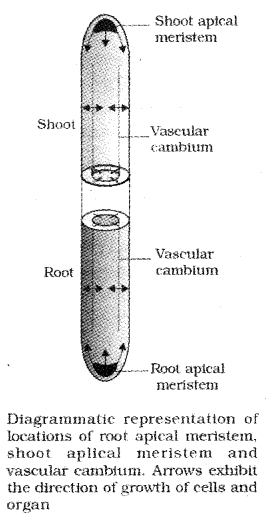
Growth is Measurable
- Growth is measured in terms of increase in fresh weight, dry weight, length, area, volume, and cell number.
- One single maize root apical meristem can give rise to more than 17,500 new cells per hour, cells in a watermelon increase in size by up to 3,50,000 times.
- In the former, growth is expressed as an increase in cell number.
latter expresses growth as an increase in the size of the cell. - While the growth of a pollen tube is measured in terms of its length, an increase in surface area denotes the growth in a dorsiventral leaf.
Phases of Growth
The period of growth is generally divided into three phases.
- Meristematic: The constantly dividing cells, both at the root apex and the shoot apex, represent the meristematic phase of growth.
- Elongation: The cells proximal to the meristematic zone represent the phase of elongation.
- Maturation: Proximal to the phase of elongation represents the phase of maturation.
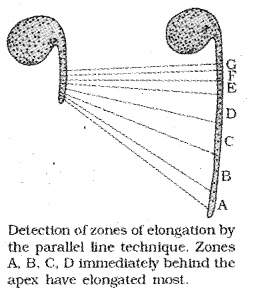
Growth Rates
The increased growth per unit time is termed as growth rate. The growth rate may be
- Arithmetic
- Geometrical
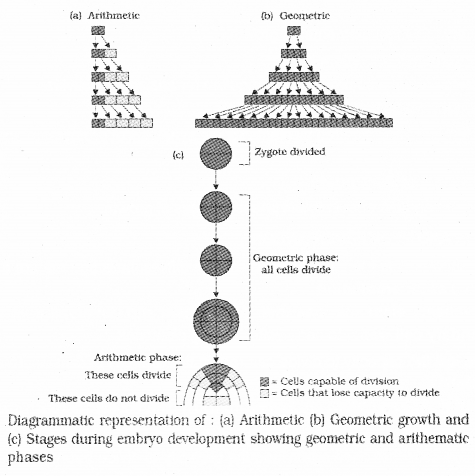
On plotting the length of the organ against time, a linear curve is obtained, it is expressed as

Lt = L0 + rt
Lt = length at time ‘t’
L0 = length at time ‘zero’.
r = growth rate/elongation per unit time.
Different phases of the Sigmoid curve
- lag phase
- log or exponential phase
- stationary phase
In most systems, the initial growth is slow (lag phase), and it increases rapidly at an exponential rate (log or exponential phase)
In the end, due to the limited nutrient supply, the growth slows down leading to a stationary phase. It is the typical sigmoid or S-curve.
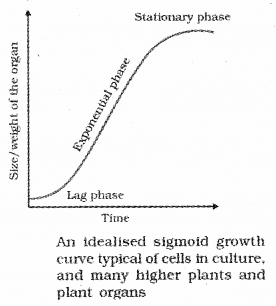
The exponential growth can be expressed as
W1 = W0 e rt
W1 = final size (weight, height, number etc.)
W0 = initial size at the beginning of the period
r = growth rate
t = time of growth
e = base of natural logarithms
Quantitative comparisons between the growth of a living system can also be made in two ways:
- Measurement and the comparison of total growth per unit time is called the absolute growth rate.
- The growth of the given system per unit time expressed on a common basis.

In Figure two leaves, A and B, are drawn that are of different sizes but show an absolute increase in area in the given time to give leaves, A1 and B1.
Conditions for Growth
Water, oxygen, and nutrients as very essential elements for growth.
The plant cells grow in size by cell enlargement it requires water.
Turgidity of cells helps in extension growth. Water also provides the medium for enzymatic activities
Oxygen helps in releasing metabolic energy essential for growth activities.
Nutrients (macro and micro essential elements) are required by plants for the synthesis of protoplasm and act as a source of energy.
An optimum temperature range is best suited for plant growth.
Environmental signals such as light and gravity also affect certain phases/stages of growth.
Differentiation, Dedifferentiation, and Redifferentiation
1. The cells derived from root apical and shoot-apical meristems and cambium differentiate and mature to perform specific functions. This is termed as differentiation.
For example, during differentiation, tracheary elements lose their protoplasm and develop a very strong, elastic, lignocellulosic secondary cell wall, to carry water too long distances.
2. The living differentiated cells, that have lost the capacity to divide can regain the capacity of division This phenomenon is termed dedifferentiation.
For example, interfascicular cambium and cork cambium is formed from fully differentiated parenchyma cells.
3. Meristems are able to divide and produce cells that once again lose the capacity to divide but mature to perform specific functions. This is called a redifferentiation.
For example, secondary tissues develop from vascular cambium and cork cambium
Development
It is the stage of the life cycle in which germination of the seed to senescence.

The plant shows a response to the environment to form different kinds of structures. This ability is called plasticity
Heterophylly is an example of plasticity
Types of Heterophylly
1. The leaves of the juvenile plant are different in shape from those in mature plants.
e.g cotton, coriander, and larkspur.
2. Shapes of submerged leaves are different from those produced in the air.
Eg buttercup.

Development is considered as the sum of growth and differentiation.
Development in plants is under the control of intrinsic and extrinsic factors.
A) Intrinsic factors
- Intracellular (genetic)
- Intercellular factors (chemicals such as plant growth regulators)
B) Extrinsic factors
Light, temperature, water, oxygen, nutrition, etc.
Plant Growth Regulators
Characteristics
The plant growth regulators (plant hormones or phytohormones) include
- Indole compounds (indole-3-acetic acid, IAA);
- Adenine derivatives (N6-furfurylamino purine, kinetin),
- Derivatives of carotenoids (abscisic acid, ABA);
- Terpenes (gibberellic acid, GA3) or
- Gases (ethylene, C2H4).
The PGRs are divided into two groups based on their functions in a living plant body.
One group of PGRs are involved in growth-promoting activities, e.g., auxins, gibberellins, and cytokinins.
The other group mainly involved in growth-inhibiting activities such as dormancy and abscission. Eg-abscisic acid and ethylene.
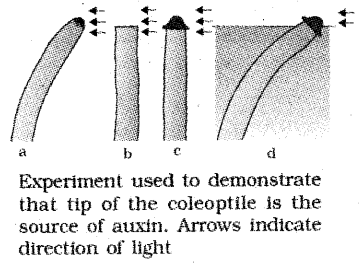
The Discovery of Plant Growth Regulators
1. Auxin
At first, Charles Darwin and his son Francis Darwin observed that the coleoptiles of canary grass responded to unilateral illumination by growing towards the light source.
After a series of experiments, it was concluded that the tip of the coleoptile was the site of transmittable influence that caused the bending of the entire coleoptile.
Auxin was isolated by F. W. Went from tips of coleoptiles of oat seedlings.
2. Gibberellin
The ‘balance’ (foolish seedling) disease of rice seedlings, was caused by a fungal pathogen Gibberalla fujikuroi.
In this experiment, the uninfected rice seedlings were treated with sterile filtrates of the fungus. It led to the development of the disease. The active substance was gibberellic acid.
It was demonstrated by E. Kurosawa.
3. Cytokinin
The internodal segments of tobacco stems- the callus proliferated in the presence of auxins along with the extracts of vascular tissues, yeast extract, coconut milk or DNA.
Skoog and Miller later identified and crystallized the cytokinesis promoting active substances that they termed kinetin.
4. Abscisic acid(ABA)
During the mid-1960s inhibitory hormones were identified: inhibitor-B, abscission II and dormin.
Later all the three were named abscisic acid (ABA).
5. Ethylene
Ripened oranges that hastened the ripening of stored unripened bananas. Later this volatile substance was identified as ethylene, a gaseous PGR.
Physiological Effects of Plant Growth Regulators
Auxins
Auxins were first isolated from human urine.
They are generally produced by the growing apices of the stems and roots, from where they migrate to the regions of their action.
Two types of auxins
- Natural (IAA and indole butyric acid (IBA)
- Synthetic. NAA (naphthalene acetic acid) and 2, 4-D (2, 4-dichlorophenoxyacetic)

- They help to initiate rooting in stem cuttings
- Auxins promote flowering e.g. in pineapples.
- They help to prevent fruit and leaf drop at early stages but promote the abscission of older mature leaves and fruits.
- In most higher plants, the growing apical bud inhibits the growth of the lateral (axillary) buds, a phenomenon called apical dominance.
- Removal of shoot tips (decapitation) usually results in the growth of lateral buds Hence it is widely applied in tea plantations, hedge-making, etc.
- Auxins also induce parthenocarpy.
- They are widely used as herbicides. 2, 4-D is used to kill dicotyledonous weeds, So it is used to prepare weed-free lawns by gardeners.
- Auxin controls xylem differentiation and helps in cell division.
Gibberellins
Gibberellic acid (GA3) was one of the first gibberellins to be discovered and remains the most intensively studied form.
GA3 is acidic.
- GA3 causes an increase in the length of grapes stalks. .
- Gibberellins, cause fruits like apple to elongate and improve its shape
- They delay senescence. Hence the fruits are keeping as fresh.
- GA3 is used to speed up the malting process in the brewing industry.
- Spraying sugarcane crop with gibberellins increases the length of the stem, thus increasing the yield by as much as 20 tonnes per acre.
- Spraying juvenile conifers with GAs hastens the maturity period, thus leading to early seed production.
- Gibberellins also promote bolting(internode elongation just prior to flowering) in beet, cabbages and many plants with rosette habit.
Cytokinins
Cytokinins were discovered as kinetin (a modified form of adenine, a purine) from the autoclaved herring sperm DNA.
Naturally occurring cytokinin-zeatin was isolated from corn-kernels and coconut milk.
Natural cytokinins are synthesised in regions where rapid cell division occurs, for example, root apices, developing shoot buds, young fruits, etc.
- It helps to produce new leaves, chloroplasts in leaves, lateral shoot growth and adventitious shoot formation.
- Cytokinins help to overcome apical dominance.
- They promote nutrient mo8/+9bilisation which helps in the delay of leaf senescence.
Ethylene
The most widely used compound as a source of ethylene is ethephon.
It is readily absorbed and transported within the plant and releases ethylene slowly.
Ethephon hastens fruit ripening in tomatoes and apples and accelerates abscission in flowers and fruits
- Ethylene is a gaseous hormone that promotes senescence and ripening fruits.
- It promotes horizontal growth of seedlings, swelling of the axis, and apical hook formation in dicot seedlings.
- Ethylene promotes senescence and abscission of plant organs, especially of leaves and flowers.
- Ethylene is highly effective in fruit ripening. It enhances the respiration rate during the ripening of the fruits (respiratory climactic).
- Ethylene breaks seed and bud dormancy and initiates germination in peanut seeds, sprouting of potato tubers.
- Ethylene promotes rapid internode/petiole elongation in deepwater rice plants.
- Ethylene also promotes root growth and root hair formation, thus helping the plants to increase their absorption surface.
- Ethylene is used to initiate flowering and fruit-set in pineapples.
- It also induces flowering in mango.
- It promotes female flowers in cucumbers
Abscisic acid
- It promotes abscission and dormancy.
- It acts as an inhibitor of plant metabolism.
- ABA inhibits seed germination.
- ABA stimulates the closure of stomata and increases the tolerance of plants to various kinds of stresses. Hence it is called the stress hormone.
- ABA plays an important role in seed development, maturation, and dormancy.
- ABA helps the seeds to withstand desiccation
- ABA acts as an antagonist to GA3.
Photoperiodism
It is the phenomenon of relative day and night length for the initiation of flowering.
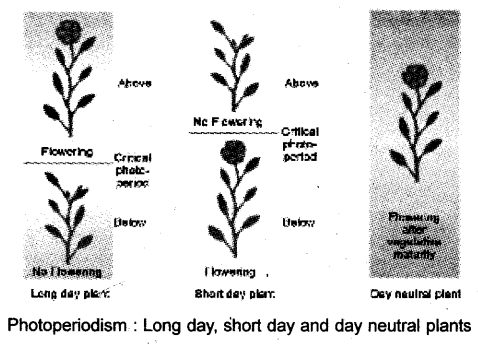
Based on the exposure to photoperiod there are three types of plants
- Long day plants: They require exposure to light for a period greater than critical duration (12 hr).
- Short-day plants: They require less than critical duration before flowering.
- Day-neutral plants: In this type, there is no such correlation between exposure to light duration and induction of flowering response.
Which is the organ of a plant perceives light for photoperiodism?
The site of perception of light/dark duration is the leaves. After receiving the required photoperiod, the hormonal substance migrates from leaves to shoot apices for inducing flowering. The shoot apices become changed into flowering apices prior to flowering.
Vernalisation
It is the phenomenon of exposure of low temperature for the initiation of flowering
Some important food plants, wheat, barley, rye have two kinds of varieties: winter and spring varieties.
Nature of spring and winter varieties
The ‘spring’variety are normally planted in the spring and come to flower and produce grain before the end of the growing season.
Winter varieties, planted in spring fail to flower or produce mature grain within a span of a flowering season.
If they are planted in autumn .they germinate and overwinter come out as small seedlings, resume growth in the spring, and are harvested usually around mid-summer.
Biennials and low-temperature treatment
Biennials are monocarpic plants that normally flower and die in the second season. Biennial plants are subjected to a cold treatment, it stimulates photoperiodic flowering response. Sugarbeet, cabbages, carrots are some of the common biennials.
NCERT Supplementary Syllabus
Seed Germination
The seeds germinate under favourable conditions after the period of dormancy.
After dormancy embryo becomes metabolically active and starts growing. This process is known as seed germination.
The conditions necessary for seed germination are the availability of water and oxygen.
A physiological phenomenon in seed germination
The physical phenomenon associated with seed germination is imbibition. It causes the swelling of seed then rupturing of the seed coat, through which radical emerges out.
It develops into a root system but the shoot system arises from the plumule of another end of the embryonal axis.
The metabolic activities require oxygen for breaking down the food reserves such as polysaccharides, proteins and lipid.
It is converted into soluble materials with the help of enzymes and mobilized to the embryonal axis.
The growth of radical and plumule is due to cell extension, cell division, and several biochemical processes.
The seed also needs a suitable temperature (optimum between 25 to35). The rate of respiration increases rapidly during seed germination.
What is the Viviparous type of germination?
Vivipary is the germination of a seed while it is still attached to the parent plant and is nourished by it. The plants grow in marshy land such as Rhizophora and Sonneratia (halophytes)show this type of germination.
During germination, radical elongates, and the weight of the germinating seed increases. As a result, the seedling separates and fail down vertically into the mud and grow into a new plant.
Seed Dormancy
It is the period of rest or a period of suspended growth due to this
- water content, the metabolic activities become extremely low.
- the seed coat becomes impermeable to oxygen and moisture and hardens.
The suspension of growth is due to exogenous (environmental conditions) or endogenous control during which metabolic activity of the seed is greatly reduced.
Causes of Dormancy
- Impermeable or mechanically resistant seed coats.
- Rudimentary or physiologically immature embryos or
- Due to the presence of germination inhibitors such as abscisic acid, phenolic acid, short-chain fatty acids, and coumarin.
How can overcome seed dormancy?
- Mechanical or chemical scarification of the seed coat (scratching of seed coat or seeds soaked in chemicals to break the dormancy)
- Stratification of seeds or changing environmental conditions such as temperature, light, and pressure. Stratification of seeds is subjecting the moist seeds to oxygen for variable periods of low or high temperatures.
